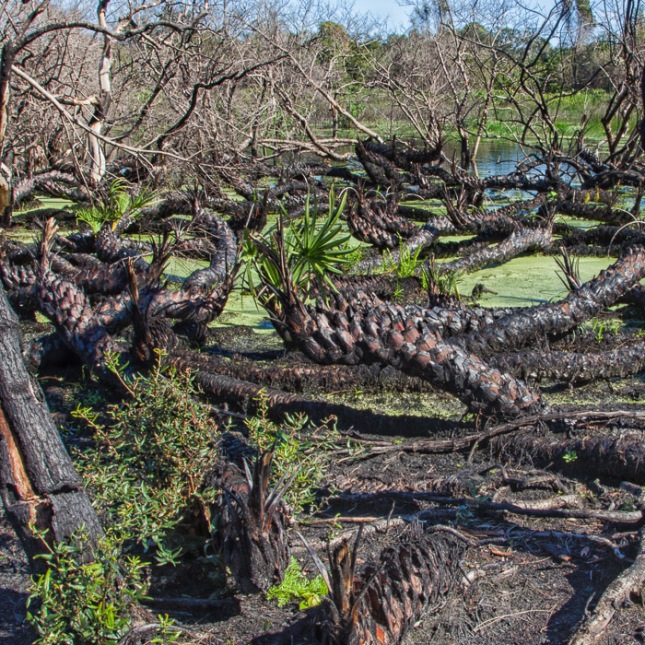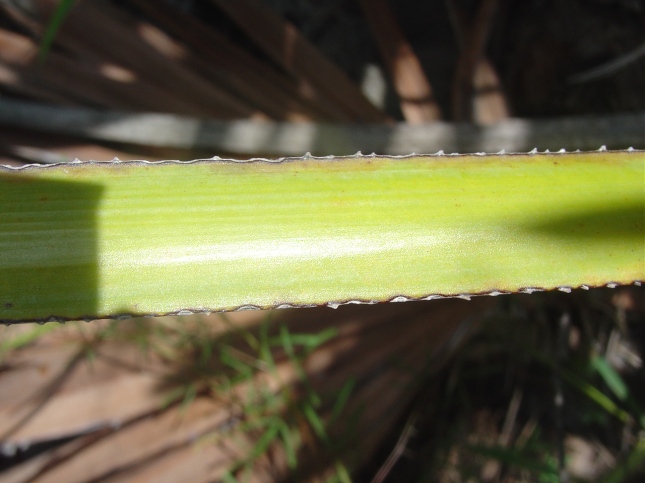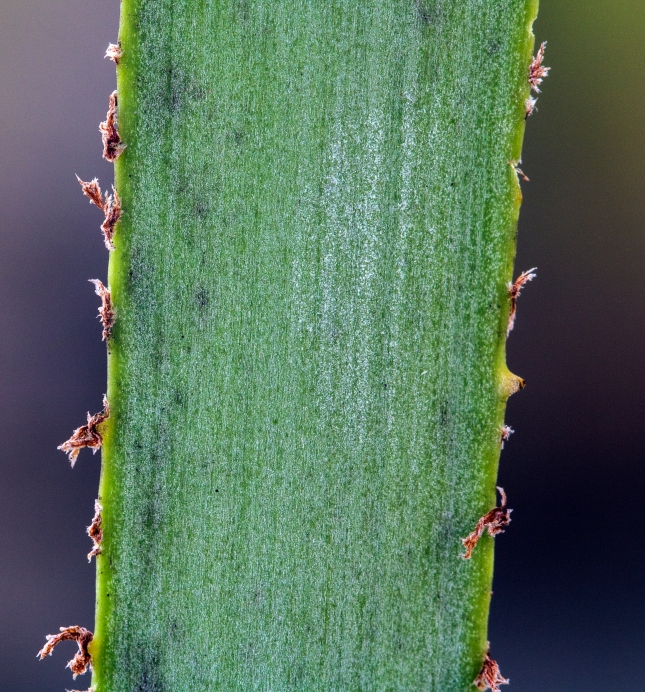Serenoa repens
(Sereno Watson was an American botanist. Repens means lying down.)
Arecaceae

Today’s sweaty trek was a lap of the Kiplinger Natural Area in Stuart with Beautyberries in purple splendor and species of Chaffheads putting on the purple as well. The sun flecks through the pines lit up the Saw Palmetto fronds like stage lights, so what the heck, today it’ll be the dominant species around here, Saw Palmetto.

Sabal etonia, Scrub Palmetto, is similar but toothless. By John Bradford.
Being everywhere and familiar to all, Saw Palmetto is festooned with Google-ish info and some mis-info. We’ll knock off the uber-documented facts expediently, knowing you can explore further on the Internet, and then ponder a couple less-obvious palmetto puzzlers.

Palmetto leaf wax, electron microscope image, by Dr. Bob Wise, Univ. WI
Well Known Stuff:
- Saw Palmettos come in silver and in green. The silver comes from wax granules making the leaf reflective and sun-tolerant. Green individuals have less sunscreen. The species grows in habitats ranging from full sun to shaded, so it makes sense to have populations mixed for this character. Some sunny types, some shady characters. Diversify, or at least that’s how I see it. The wavy covering can become discolored with black Meliola fungi, or from sooty mold.
- The so-called berries (drupes) are an industry in Florida amounting to a harvest of over 7 million kg/year. There’s a long-standing history of application for prostate health. Formal scientific studies seem to fail to confirm benefits, although the market abounds.

Fruits and ant, by John Bradford
Saw Palmetto “prunes” must have been good for Jonathan Dickinson, shipwrecked at Jupiter in 1696 and surviving with a small group of castaways partly on dried Saw Palmetto fruits while traveling under life-threatening conditions (five died) up the coast to St. Augustine. It must have been good for JD’s prostate, because he went on to become Mayor of Philadelphia.
- Saw Palmettos cook happily in fire, and recover in a jiffy.
- You can make cool darts and dart launchers from the leaf stalks, but that is beyond the scope of today.

Scorched, and on the mend, by John Bradford
Weirder Stuff:
- Saw Palmetto clones can live a long time by rhizomatous spreading and branching, even if individual above-ground shoots perish or burn. Take a guess. Botanist Mizuki Takahashi and collaborators recently compiled evidence suggesting maybe 10,000 years. That’s almost back to the Pleistocene Epoch. I could eat Saw Palmetto fruits from the same clone as Jonathan Dickinson, but I don’t want to. He and I agree they are revolting. I’d rather eat a pickled prostate.
- The roots have air channels, hollow pipes conducting air who knows how deep into the underground. Down-bound air channels are common in marsh plant in suffocating waterlogged soil. Perhaps my ignorance is showing, but Saw-Palmetto is the only example of rooty air ducts I know in a scrub-dweller. The species, however, is not restricted to scrub. Maybe the air ducts allow the roots to go extra-deep in the seasonally soggy-to-waterlogged pine woods soils where Saw Palmetto rules. The roots need study by somebody with a shovel and a strong back

Flowers by JB
- The leaf stalks (petioles) have saw teeth. Duh, everyone knows that. That’s why it’s called Saw Palmetto. But why the teeth? The obvious answer is to protect the palms from animals who might eat it, or might climb into it to eat unripe fruit or flowers, or might trample it. Perhaps, although to my outlook it is hard to imagine any animals being a big threat now or earlier in the plant’s evolution, even those giant Pleistocene herbivores mashing around. But you never know. In any case to go a bit beyond, any other potential benefits from the dentition? Maybe:
Although I’ve never heard it said about Saw Palmetto (perhaps missed it), I have seen speculation that the Saw-Grass saw blades blow in the wind to slice and dice competing plants. Makes sense for Saw Palmetto. The leaves last 3-3.5 years, too long to tolerate pesky vines encroaching. Look out across a stand of Saw Palmetto. Even when the non-Palmetto plants are all entangled, the Palmetto tends to be relatively free.
Saw Palmeto is most closely related to the Paurotis Palm, which has big petiole teeth. Those on Saw Palmetto may be more or less vestigial from big-tooth predecessors.

Prickles by JB
The teeth come in varied shapes, the biggest and best hooking back. The leaf blade is a big sail attached to a long flexible petiole with those recurved teeth. With its blade twerking in the wind, the sawtooth petiole would almost have to snag and yank any vines it contacts.

Why are these prickles so tatty?
Evidence that that might (repeat, might) be true comes from a magnified peep at the teeth, especially near the tops of the petioles, where the teeth tips sometimes appear abraded and frazzled as though worn out. A dull saw, perhaps?

The rare Kiplinger prostativore, snapped by JB







